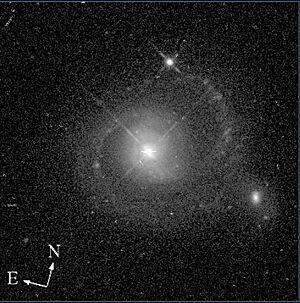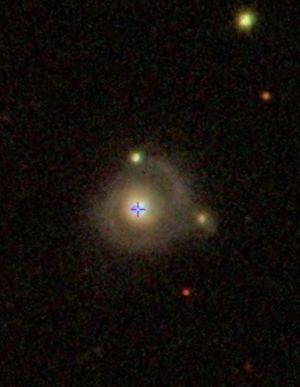I Zwicky 1 facts for kids
Quick facts for kids I Zwicky 1 |
|
|---|---|

Hubble Space Telescope image of I Zwicky 1
|
|
| Observation data (J2000 epoch) | |
| Constellation | Pisces |
| Right ascension | 00h 53m 34.94s |
| Declination | +12d 41m 36.20s |
| Redshift | 0.061169 |
| Helio radial velocity | 18,338 km/s |
| Distance | 847 Mly (259.7 Mpc) |
| Type | Sa;Sy1, Sbrst |
| Apparent magnitude (V) | 0.43 |
| Notable features | Seyfert galaxy containing a quasar |
| Other designations | |
| UGC 545, PG 0050+124, PGC 3151, IRAS 00509+1225, RBS 0129, 2E 209, PHL 3072, Mrk 1502, Mrk 9009, NVSS J005334+124133 | |
| See also: Galaxy, List of galaxies | |
I Zwicky 1 (often called I Zw 1) is a fascinating galaxy found in the Pisces constellation. It's about 847 million light-years away from Earth. Scientists believe it might be the closest quasar (QSO) because it shines incredibly brightly from its center.
Contents
Discovery of I Zwicky 1
Who Discovered It?
The galaxy I Zwicky 1 was first spotted by a scientist named Fritz Zwicky in 1964. He described it as a "variable blue spherical" object that was very compact. It was the very first object listed in his special "Zwicky catalogue" of galaxies.
How Brightness Changes
Scientists have looked at old Harvard photographic plates from as far back as 1909 to study I Zwicky 1. These old pictures show that the galaxy's brightness changes over time. It can have sudden bursts of light, making it appear much brighter.
What is Redshift?
When scientists look at light from distant objects like I Zwicky 1, they notice something called redshift. This means the light waves are stretched out, making them appear redder. It tells us that the galaxy is moving away from us. For I Zwicky 1, its redshift shows it's moving very fast, similar to other distant quasars.
What Makes I Zwicky 1 Special?
An Active Heart

At the very center, or nucleus, of I Zwicky 1, there's a lot of activity! It's known as an active galactic nucleus (AGN). This galaxy is a special type called a Seyfert 1 galaxy. It shines very brightly in X-rays, which are a type of light we can't see.
Unique Light Signature
When scientists look at the light coming from I Zwicky 1, they see a unique pattern called a spectrum. This spectrum shows different "lines" of light. I Zwicky 1 has some unusual lines that tell us about the gases moving around its center. These special lines make it a very interesting object to study.
A Spiral Home
The bright quasar at the center of I Zwicky 1 lives inside a spiral galaxy. Imagine a giant pinwheel in space! This galaxy has two asymmetric spiral arms that aren't perfectly even. In these arms, new stars are being born in areas called "knots of star formation." Studying I Zwicky 1 helps us understand how quasars affect their home galaxies.
Bursts of New Stars
I Zwicky 1 is also known as a Markarian galaxy. Its center gives off a lot of ultraviolet light. This happens because the galaxy is going through a strong "starburst." A starburst is when many new stars form very quickly in a specific area, like a ring around the galaxy's center.
How Scientists Study I Zwicky 1
Scientists use many different tools to learn more about I Zwicky 1. They look at the light it gives off in various ways, including visible light, infrared light, and even X-rays.
Looking at Gases and Dust
Researchers have studied the carbon monoxide gas in I Zwicky 1. This gas is found in giant molecular clouds, which are like cosmic nurseries where new stars are born. By studying these gases, scientists can understand how stars form in the galaxy's disk and around its active center.
They've found that about two-thirds of the galaxy's far-infrared light comes from its main disk, and one-third comes from its bright nucleus. This helps them figure out how fast new stars are forming in different parts of the galaxy.
Using Special Telescopes
To get a clearer picture, scientists use powerful telescopes that can see different types of light. For example, they've used large radio telescopes in France to map the carbon monoxide gas. They also use telescopes in Spain and the Canary Islands to take detailed images and study the galaxy in near-infrared light. These observations help them understand the galaxy's structure and how its active center works.
Molecular Gas in I Zwicky 1
Gas for Star Formation
The molecular gas in a galaxy is super important because it's where new stars are made. It also helps power the super-bright centers of active galaxies (AGNs). Scientists have found a lot of this gas in the spiral arms of I Zwicky 1.
They've even discovered a ring of molecular gas around the galaxy's center. This ring is similar in size to other "starburst rings" found in galaxies close to us. Even with very detailed observations, scientists haven't seen this gas flowing directly into the galaxy's nucleus.
Starburst Rings: A Common Feature?
How Rings Form
Scientists believe that the starburst rings in I Zwicky 1 might have formed because of strong gravitational pulls. These rings are areas where lots of new stars are being born very quickly. They are made of gas and dust that get squeezed together.
The rings in I Zwicky 1 aren't perfectly smooth. It's possible they are formed by the galaxy's spiral arms twisting around its center.
Comparing with Other Galaxies
To understand if these rings are special, scientists compared I Zwicky 1 to two other galaxies: NGC 7552 and NGC 7469. They found that the ring properties are quite similar for all three galaxies. However, there are some differences in how much total light they give off.
The starburst rings in I Zwicky 1 seem to be about three times older than those in NGC 7552 and NGC 7469. This suggests that these rings, where many stars are forming, contribute a lot to the overall brightness of the galaxy's central parts. It's not just the super-bright quasar that makes the galaxy shine!
The Supermassive Black Hole
A Giant at the Center
Like most large galaxies, I Zwicky 1 has a supermassive black hole at its very heart. Scientists estimate its mass to be about 9.3 million times the mass of our Sun! This black hole is very active, pulling in a lot of material around it.
X-Ray Flares and Light Echoes
Observations from powerful space telescopes like ESA's XMM-Newton and NASA's NuSTAR have shown something amazing: this black hole shoots out powerful X-ray flares! These are like sudden, bright flashes of X-ray light.
Scientists have also detected "light echoes." Imagine shouting in a canyon and hearing your voice bounce back. These light echoes are flashes of light that bounce off the accretion disk – a swirling disk of gas and dust around the black hole. The black hole's incredibly strong gravitational field can even bend and stretch these light echoes, giving us clues about this mysterious region.

